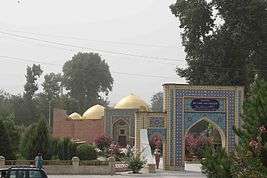Mir Sayyid Ali Hamadani
| Mir Sayyid Ali Hamadani | |
|---|---|
| میر سید علی ہمدانی | |
| Religion | Islam |
| Personal | |
| Born |
714 AH (1314 AD) Hamedan, Persia |
| Died |
786 AH (1384 AD) Kunar, Afghanistan |
Part of a series on Islam Sufism |
|---|
|
|
List of sufis |
|
|
Mir Sayyid Ali Hamadani (Persian: میر سید علی ہمدانی; 1314–1384) was a Persian Sūfī of the Kubrawiya order, a poet and a prominent Shafi'i Muslim scholar.[1][2] He was born in Hamadan, and was buried in Khatlan Tajikistan.[3] He played a major role in spreading Islam in Kashmir and also influenced the culture of the Kashmir valley. He was known as Shāh-e-Hamadān ("King of Hamadān"), Amīr-i Kabīr ("the Great Commander"), and Ali Sani ("second Ali").[4]
Early life
Hamadani spent his early years under the tutelage of Ala ud-Daula Simnani, a famous Kubrawi saint from Semnan, Iran. Despite his teacher's opposition to Ibn Arabi's explication of the wahdat al-wujud ("unity of existence"), Hamadani wrote Risala-i-Wujudiyya, a tract in defense of that doctrine, as well as two commentaries on Fusus al-Hikam, Ibn Arabi's work on Al-Insān al-Kāmil. Hamadani is credited with introducing the philosophy of Ibn-Arabi to South Asia.[5]
Travels
Hamadani traveled widely – it is said he traversed the known world from East to West three times. In 774 AH/1372 AD Hamadani lived in Kashmir. After Sharaf-ud-Din Abdul Rehman Bulbul Shah, he was the second important Muslim to visit Kashmir. Hamadani went to Mecca, and returned to Kashmir in 781/1379, stayed for two and a half years, and then went to Turkistan by way of Ladakh. He returned to Kashmir for a third time in 785/1383 and left because of ill health. Hamadani is regarded as having brought various crafts and industries from Iran into Kashmir; it is said that he brought with him 700 followers, including some weavers of carpets and shawls, who taught the craft of pashmina textile and carpet-making to the local population.[5] Ladakh likewise benefited from his interest in textile weaving. The growth of the textile industry in Kashmir increased its demand for fine wool, which in turn meant that Kashmiri Muslim groups settled in Ladakh, bringing with them crafts such as minting and writing.[6]
Hamadani travelled and preached Islam in different parts of the world[7] including Afghanistan, Uzbekistan, China, Syria, and Turkestan.[8]

Hamadani died in Kunar Province Afghanistan . His body was carried to Khatlan, Tajikistan, where his shrine is located.[5]
Influence
His disciple Sayyid Ishaq al-Khatlani was in turn the master of Shah Syed Muhammad Nurbakhsh Qahistani.[9]
Works
One manuscript (Raza Library, Rampur, 764; copied 929/1523) contains eleven works ascribed to Hamadani (whose silsila runs to Naw'i Khabushani; the manuscript contains two documents associated with him).[10]
References
- ↑ Al-islam.org
- ↑ Ninth Session, Part 2
- ↑ Hadith alThaqalayn || Imam Reza (A.S.) Network
- ↑ Sir Walter Roper Lawrence (2005). The Valley of Kashmir. Asian Educational Services. p. 292. ISBN 978-81-206-1630-1.
- 1 2 3 Rafiabadi, Hamid Naseem (2003). "World Religions and Islam: A Critical Study, Part 2". Sarup & Sons. pp. 97–105. ISBN 9788176254144.
- ↑ Fewkes, Jacqueline H. (2008). Trade and Contemporary Society Along the Silk Road: An Ethno-history of Ladakh. Routledge Contemporary Asia. Routledge. pp. 44–45. ISBN 9781135973094.
- ↑ Stellrecht, Irmtraud (1997). The Past in the Present: Horizons of Remembering in the Pakistan. Rüdiger Koppe. ISBN 978-38-96451-52-1.
- ↑ Barzegar, Karim Najafi (2005). Intellectual movements during Timuri and Safavid period: 1500–1700 A.D. Delhi: Indian Bibliographies Bureau. ISBN 978-81-85004-66-2.
- ↑ Deweese, Devin (2014). "Intercessory Claims of Sufi Communities: Messianic Legitimizing Strategies on the Spectrum of Normativity". In Mir-Kasimov, Orkhan. Unity in Diversity: Mysticism, Messianism and the Construction of Religious Authority in Islam. Brill. pp. 197–220. ISBN 978-90-04262-80-5.
- ↑ Deweese, Devin (2005). "Two Narratives on Najm al-Din Kubra and Radi al-Din Lala from a Thirteenth-Century Source: Notes on a Manuscript in the Raza Library, Rampur". In Lawson, Todd. Reason and Inspiration in Islam: Essays in Honour of Hermann Landolt. I.B. Tauris. pp. 298–339. ISBN 9780857716224.
External links
Bibliography
- John Renard 2005: Historical Dictionary of Sufism (Historical Dictionaries of Religions, Philosophies and Movements, 58), ISBN 0810853426